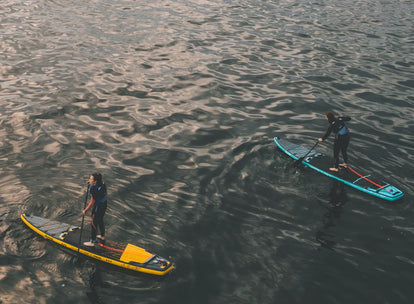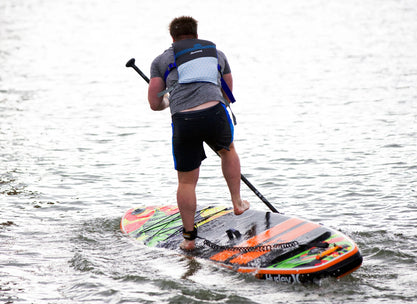From the sidelines, paddle boarding looks pretty epic. It’s little surprise that it’s one of the fastest-growing activities in the world. Why not join the increasing number of people taking to the water?
You don’t need to be any kind of expert in paddle boarding to have a whale of time on the water. You don’t even need to be able to stand up right away. As you paddle along, you’re leaving any stress behind, clearing your head and giving your body a good workout.
Over time, as you get more comfortable on your board, you can search for new places to take your new hobby – how far and wide you go is entirely up to you! If you’ve got a competitive streak, pit your new-found skills against other paddle boarders in games such as SUP polo or racing.
But that’s all to come. The first thing you need to do is go out and buy the kit. Here’s everything that you’ll need to get out on the water, come rain or shine.
Picking your board

Let’s start with the most exciting purchase: the board. You might have done a quick search of boards and been met with a raft of options. It’s enough to put you off! There’s plenty to weigh up. Don’t worry, we’ve got you covered.
-
Inflatable vs Solid:

The first thing you need to decide is whether you want an inflatable or solid paddleboard. Solid boards have their advantages in terms of set-up time and composition, but if you want to take your new hobby on the road (you will), you’ll find it a lot easier with an inflatable stand up paddle boards (iSUPs).
With an iSUP, you don’t have to give any thought to how to transport it – they are designed to pack down to fit inside a backpack. This convenience doesn’t come at a cost either – they are often cheaper than solid SUPs. Once inflated with a pump, they become rigid.
For the best of both worlds, consider the Aquaplanet MAX SUP. This sturdy board is made for beginners, providing maximum balance on the water.

-
Surf vs Allround vs Flatwater

There are three basic types of stand-up paddleboards: surf, allround, and flatwater/race.
So, while thinking about whether you plan to take your board on the road, you need to consider what kind of water you’ll be paddling on. At this stage, you probably won’t want to rule anything out.
Therefore, an allround paddle board – which is fit for rivers, calm seas and small waves – is likely to be your best bet. The Aquaplanet ALLROUND TEN SUP is a fun, responsive and light board that can be used for surfs, long strolls and balance.
However, if you have a need for speed, the Aquaplanet PACE SUP with its signature pointed shape, lets you cut into waves with style, while its extra thickness gives you supreme stability and buoyancy.
Before deciding which board is right for you, you need to factor in your weight. On the Aquaplanet website, you will see a recommended rider weight for each board in our shop.
Choosing your paddle

The average paddler takes up to 1,500 strokes per hour. With a huge amount of strokes being made during your time out on the water, the size, weight and comfort factor of your paddle have to be just right.
There are three elements of a paddle: the handle, shaft and blade.
SUP paddle handles either have an ergonomic design to lock into the palm of your hand or a straighter 'T bar' feel.
Some experienced paddle boarders prefer the more traditional feel. But, as a beginner, you want to opt for a paddle with comfort grip, which increases speed and force, helping you glide through the water.
The shaft is arguably the most important part of the paddle. Carbon is the most common material used for the shaft as they make for a lightweight paddle which cut the water effortlessly.
SUP blades vary in size. A large blade will displace more water in the paddle stroke, but take more shoulder strength to use. Sleeker blades are preferred by many paddle boarders for this reason, which allow users to glide smoothly with both precision and speed without the shoulder ache.
Finally, when sizing up your paddle in line with your height, the best advice is to opt for a one-size-fits-all,quick-adjust telescopic system, which can be adjusted accordingly.
Decide on your accessories
Whenever you’re on or in water, you need to give plenty of thought to your safety. There are a few accessories that can improve your paddle boarding experience and keep you out of danger.
-
SUP leashes – Your paddle board will come with a leash, an important piece of safety kit to keep you attached to your board if you fall off and ensure you don’t get separated from it.
However, choosing the right kind of leash is really important – in surfing conditions or on clear open water then the ankle or calf leashes are ideal, but in any moving water or waterways with overhanging or underwater obstructions then adding a quick release waist or chest belt to your leash is strongly advised. This means you can manually release yourself from the board in the case of any entanglements and safely swim away.

-
Buoyancy aid - a buoyancy aid brings more benefits than just assisting flotation. They provide insulation, impact protection and help reduce cold water shock should you find yourself tumbling in.The most modern ones can even give you somewhere to stow away your smartphone as you paddle.

-
Wetsuit – even in the summer months, UK waters are pretty chilly! With a nice thick wetsuit keeping your body insulated, you can extend the paddle season well past the warm days of summer and even into the cold winter.
Buying everything separately can prove pretty expensive. That’s why at Aquaplanet our SUP packages come with everything you need to get out on the water safely. It’s one of the reasons we’re one of the UK’s best-selling paddle board manufacturers.
Where to paddle?

One of the great things about paddle boarding is its versatility - you can take your iSUP pretty much anywhere there’s a body of water, be it inland, coastal or the open sea. But it’s important to make smart choices about where to paddle, it can get dangerous out there, so be careful.
If you are looking for more inspiration on where to paddle board feel free to join our Stava club with other enthusiasts, who regular post their SUP routes.


